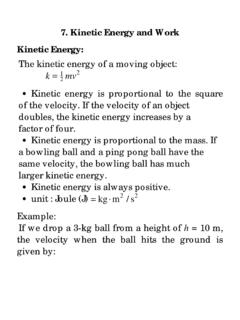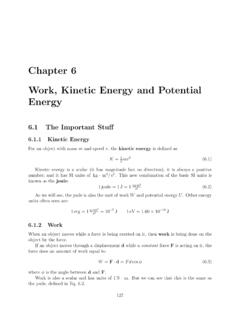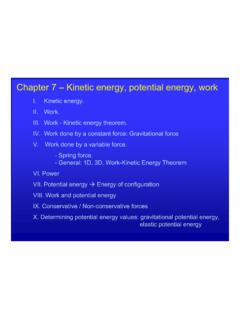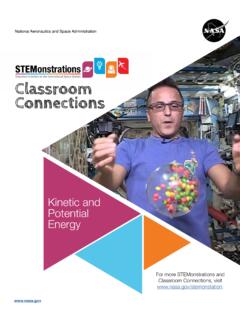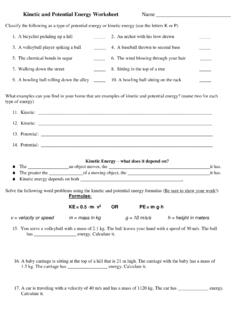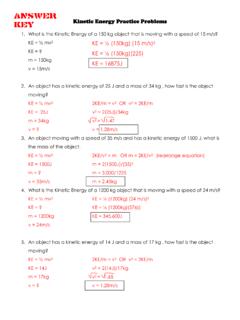Transcription of Harnessing Kinetic Energy from Humans - Sustainability
1 1 Cary Hairfield Geos 206: Renewable Energy and the Sustainable Campus Professor David Dethier May 14th, 2013 Harnessing Kinetic Energy from Humans Introduction Energy is everywhere and this semester I have learned many different ways in which Energy can be harnessed and utilized. Beginning with a study of coal I learned that in 2002 coal [was] used to generate more than 50 percent of the Nation s electric Energy (Groat, 61). This was mostly due to the fact that coal is abundant in the thus relatively inexpensive (Schweinfurth, 65). Coal is an example of a raw material being removed from beneath the earth s surface in order to generate electricity. Other types of raw materials that can also be used for this purpose include petroleum and natural gas.
2 Figure 1 illustrates that as of 2011 coal was used to generate 20 percent of our nation s electric Energy , natural gas was used to create 26 percent and petroleum was used to generate 36 percent ( Energy Information Administration/Annual Energy Review 2011). Using raw materials to generate electric Energy , however, creates an abundance of other issues that our society is left to grapple with. In fact, critical issues in public and political affairs of human society ultimately have an energetic basis (Odum, 34). One of the issues with using coal, petroleum, and natural gas is that they emit greenhouse gases into our environment that increase global warming. In an effort to halt this increase, new ways in which Energy can be harnessed are being invented.
3 These different types of methods are called renewable Energy sources because they do not emit greenhouse gases in order to produce electric Energy . I have always been most interested specifically in renewable and sustainable sources of Energy . In fact, renewable and sustainable Energy sources will be imperative as the world population continues to grow and create more waste. Some of the types of renewable Energy sources we have studied this past semester include solar power, wind Energy and hydropower. All three of these methods extract Energy from nature. However, unlike raw materials, nothing has to be removed from the earth. These technologies are Harnessing Energy by converting Energy that already exists into electric Energy .
4 These methods though are not without their own set of flaws. One of the largest issues with solar power, wind Energy and hydropower is that to a certain extent they are unpredictable. For example, at a certain point hurricanes are predictable. However, hurricanes can only be predicted once they have come to be. There is no way to predict every hurricane that will occur in the future. This idea has motivated me to look into renewable types of Energy that can more easily be predicted. For this project I will explore the ways in which Energy can be harnessed from the Kinetic movements of Humans and converted into electric Energy . 2 1. Piezoelectricity Discovered by French physicists Jacques and Pierre Curie in 1880 (Ultrasound), piezoelectricity is the accumulation of electric charge in certain solid materials.
5 For example, most notable materials include different types of crystals, however certain ceramics and biological matter can have piezoelectric qualities as well. Examples of biological matter with piezoelectric qualities include bone, tendon, wood, DNA and multiple different proteins (Principles of Instrumental Analysis). Examples of crystals with piezoelectric properties are tourmaline, berlinite, quartz, topaz, cane sugar and Rochelle salt. Quartz (Figure 2) and Rochelle salt exhibit the most piezoelectricity. A working definition of piezoelectricity is the generation of electricity or of electric polarity in dielectric crystals subjected to mechanical stress, or the generation of stress in such crystals subjected to an applied voltage (The Free Dictionary).
6 In other words, for a material to have piezoelectric properties it must not only generate electricity when a force is applied to it, but also change shape when high voltage is applied to it. This is called the converse piezoelectric effect. The Curies did not discover the converse effect, however, it was mathematically deduced from fundamental thermodynamic principles in 1881 by Gabriel Lippmann (Lippmann, Principles of the Conservation of Electricity). The Curies took Lippmann s discovery and went on to obtain quantitative proof of the complete reversibility of electro-elasto-mechanical deformations in piezoelectric crystals. 2. The Math behind Piezoelectricity Piezoelectricity is the combination of two main factors: Hooke s Law and the electrical behavior of the material in question.
7 Hooke s Law states that S = sT where S is strain, s is compliance and T is stress. The electrical behavior of the material can be derived using the equation D = E, where D is the electric charge density displacement, is permittivity and E is the electric field strength. 3. Piezoelectricity Implemented in Everyday Life Piezoelectricity is a source of high voltage, thus power. Some substances, such as quartz for instance, can create potential differences of thousands of volts of electricity. An example of piezoelectricity being implemented in everyday life is the electric cigarette lighter. As Figure 3 illustrates, by pressing the button on the top of the lighter a spring-loaded hammer is caused to hit a piezoelectric crystal.
8 This application of mechanical stress on the piezoelectric crystal produces a sufficiently high voltage electric current. The current then flows across a small spark gap, which heats and ignites the gas within the lighter. Approximately million adults smoke cigarettes, which means that at least this many people are using piezoelectricity on a regular basis (Centers for Disease Control and Prevention). 3 4. Piezoelectricity Harnessing human Movement Humans do not always understand the ways in which they are a part of an Energy cycle. In order to maintain a healthy lifestyle the average person is supposed to walk 10,000 steps a day. In other terms, the average person should be traveling five miles by foot every twenty-four hours (Parker-Pope, New York Times).
9 This equates to a lot of human motion. In fact, in order for the average adult to be capable of transporting himself this far he is supposed to eat about 2,000 calories. However, depending on the person s basal metabolic rate, amount of physical activity and thermal effect of food, this number is subject to change (Discovery, Fit and Health). Their bodies virtually function as Energy converters but instead of converting solar Energy into electric Energy for instance, they are converting Energy from food into Kinetic Energy . The Kinetic Energy can be harnessed; much like some hydropower technologies harness water movement. A way to convert this Kinetic Energy into electric Energy is through piezoelectricity.
10 By applying a mechanical stress to a piezoelectric crystal or material an electric current will be created and can be harvested. The Defense Advanced Research Projects Agency is an agency of the United States Department of Defense that researched a way in which battlefield equipment could be powered by piezoelectric generators embedded in soldiers boots. The project was called Energy Harvesting and was not successful, however, it is a good example of how people are trying to implement piezoelectric materials in order to harness Kinetic Energy as a renewable Energy source. A more successful example of piezoelectric materials creating Energy can be found at Bar Surya. Named as the world s first eco-nightclub, it is powered by solar panels and a wind turbine.
